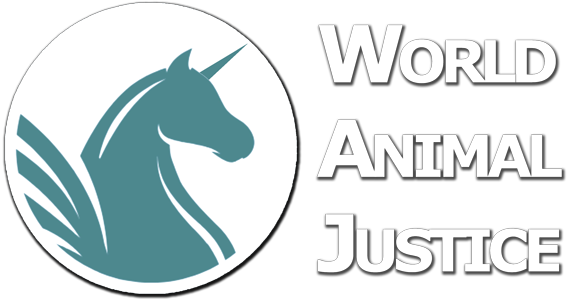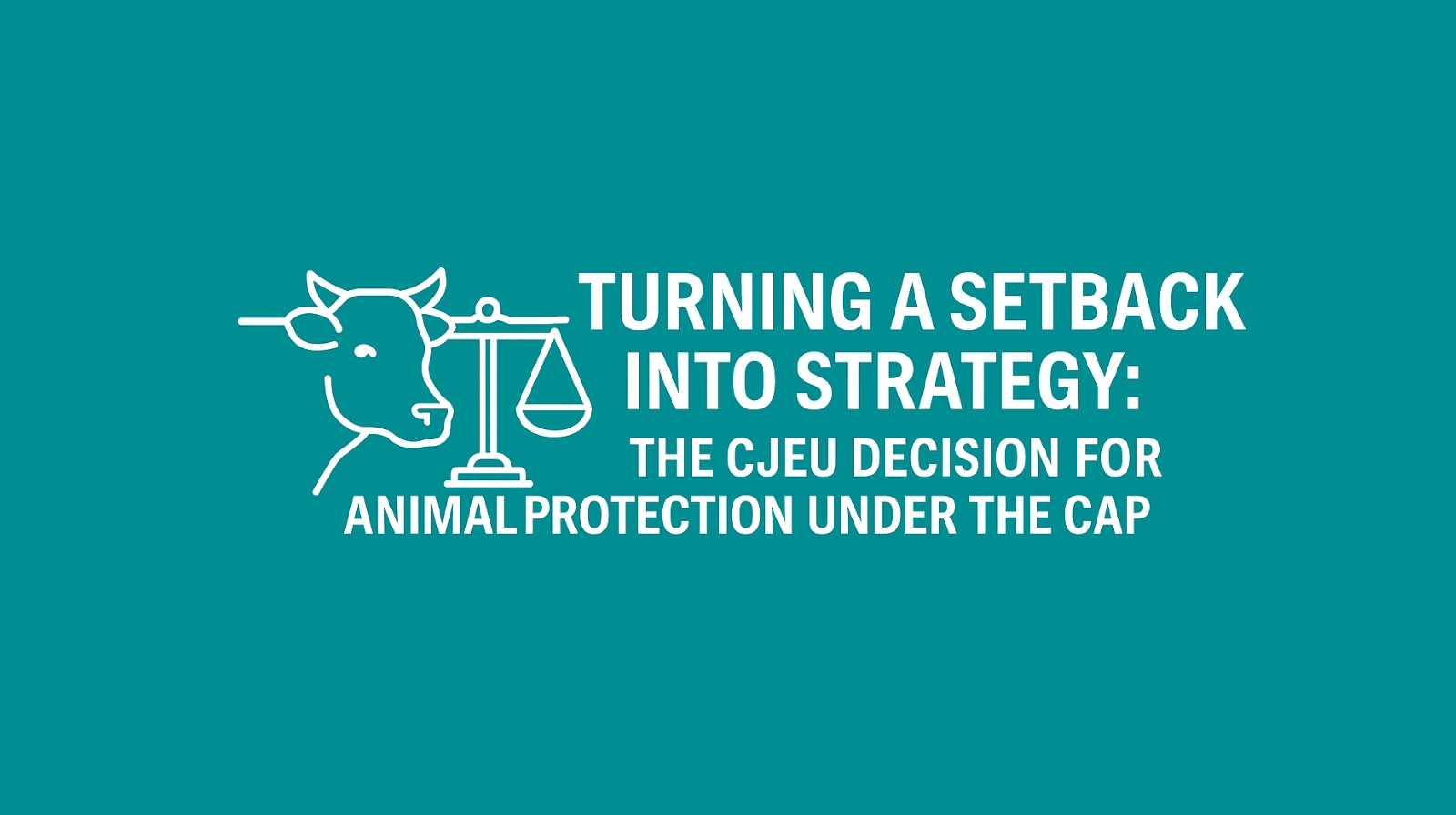Turning a Setback into Strategy: What the CJEU’s Decision Means for Animal Protection under the CAP
Background
On 29 October 2025, the General Court of the European Union (CJEU) delivered its judgment in Case T-399/23 – ClientEarth & Collectif Nourrir v European Commission.
The applicants — environmental NGOs ClientEarth (Belgium) and Collectif Nourrir (France) — had challenged the European Commission’s approval of France’s Common Agricultural Policy (CAP) National Strategic Plan under Regulation (EU) 2021/2115 (the “CAP Strategic Plans Regulation”).
They argued that the Commission failed to properly assess whether France’s plan would effectively meet EU environmental and climate objectives, including those on greenhouse gas reduction, water protection, and biodiversity — objectives that also underpin many animal-welfare concerns.
However, the Court rejected the action, upholding the Commission’s decision and confirming that the French plan remains valid.
Full judgment (English):
Curia Document – Case T-399/23, 29 Oct 2025
The Court’s Findings
The General Court made three core findings that define how future CAP-related cases will unfold:
1- Limited Commission Review Powers
The Court accepted the Commission’s interpretation that its role under Article 118 of Regulation 2021/2115 is limited to verifying the overall coherence of a Member State’s plan with the CAP’s general objectives — not to conduct an in-depth evaluation of each measure’s environmental effectiveness.
This means the Commission can approve a plan even if individual measures (e.g., livestock subsidies) appear weak or counterproductive, as long as the plan’s overall strategy appears coherent with EU goals.
2- High Threshold for Legal Challenges
To annul a CAP approval decision, applicants must show a “manifest error of assessment” — a high legal standard.
It requires proof that the plan is obviously incapable of contributing to EU environmental objectives.
This effectively narrows the room for direct challenges at the plan-approval stage.
3- Member State Discretion
The judgment reinforces that Member States have wide discretion in designing agricultural interventions, provided they stay within CAP objectives.
This gives governments considerable latitude in how they support livestock and crop systems — including intensive animal farming — so long as the plan, on paper, contributes to biodiversity and climate goals.
A Setback — But Not the End
This decision can fairly be described as a setback for environmental and animal-protection advocates.
- It confirms that the Commission’s oversight role is limited, leaving weaker scrutiny of national CAP measures that affect animals, climate, and ecosystems.
- It raises the bar for judicial review, requiring NGOs to prove a manifest and obvious error rather than merely weak or insufficient measures.
- It reduces accountability at the EU level by placing greater discretion in Member States’ hands.
Yet, this “setback” also illuminates a roadmap.
The Court’s reasoning clarifies where advocacy and litigation must now focus — downstream, at the stages of implementation, enforcement, and policy reform.
In this sense, the judgment does not close the door on accountability — it shows which doors to open next.
Why This Matters for Animal Welfare
While animal welfare is not (yet) a core CAP objective, Article 6(1)(f) of the Regulation explicitly references biodiversity, ecosystems, and habitats, all of which intersect with animal protection.
However, the Court’s interpretation of limited oversight means that animal-welfare implications of CAP subsidies—such as those supporting intensive livestock systems—may escape meaningful scrutiny at the EU-approval stage.
The risk is clear:
National CAP funds may continue to sustain industrial animal farming that undermines biodiversity, pollutes water systems, and emits high greenhouse gases — yet still meet formal CAP approval requirements.

Lessons Learned for Animal & Environmental Advocates
This judgment closes one door but opens several others. It clarifies where animal-law and environmental advocates must now focus their efforts.
1- Focus Downstream: Implementation, Not Just Approval
Challenges to the approval stage are legally constrained.
Instead, advocates should target how national CAP measures are implemented and funded — especially those that harm animals or ecosystems.
Possible approaches include:
- Challenging national or regional funding decisions under administrative law;
- Invoking EU environmental directives (Water Framework, Nitrates, Habitats) where CAP-funded activities cause pollution or biodiversity loss;
- Filing complaints with the European Commission (DG ENV or DG SANTE) for breaches of environmental or welfare law.
2- Build Cases Around EU Legal Obligations
Even with CAP approval, Member States must still comply with binding EU directives and national targets.
Failure to achieve these objectives — e.g., continued water pollution from manure or loss of grassland habitats — creates openings for enforcement action or strategic litigation.
3- Strengthen the Animal-Welfare Lens in the Next CAP
The next CAP reform (post-2027) is a key political opportunity.
Advocates can push for:
- Mandatory animal-welfare objectives within the CAP framework;
- Binding indicators on animal welfare, biodiversity, and climate impact;
- Eco-schemes that reward high-welfare, low-impact systems (e.g., pasture-based livestock, agroecology, rewilding).
4- Use the Aarhus Regulation Strategically
Even though ClientEarth’s internal review request was rejected, the process remains a powerful procedural tool:
- File requests for internal review of Commission decisions under the Aarhus Regulation (Reg. 1367/2006);
- Demand access to CAP data, including beneficiaries and environmental impact assessments;
- Build cumulative evidence of systemic CAP failures for future EU reforms or complaints.
5- Link Animal Welfare to the Green Deal
Integrate animal protection into the broader environmental framework — climate, water, soil, and biodiversity are all connected.
The EU Green Deal and Farm to Fork Strategy provide leverage for reframing animal-welfare reform as part of sustainable food-system transition.
Focus: Opportunities in France
Since the challenged plan concerns France, here are targeted levers for French and EU-level advocates:
- Challenge intensive livestock support through the Water Framework and Nitrates Directives — especially in pollution-sensitive regions (Brittany, Pays de la Loire).
- Submit evidence to the European Commission showing that CAP subsidies conflict with EU emission-reduction or biodiversity targets.
- Engage in the annual CAP plan review process by the Ministère de l’Agriculture et de la Souveraineté Alimentaire to propose eco-schemes favouring extensive, high-welfare farming.
- Monitor and publish CAP beneficiary data linking public funds to poor animal-welfare or environmental performance.
These concrete actions allow advocates to use national enforcement routes while aligning with EU environmental law.
The judgment underscores that law alone is not enough — advocacy must integrate legal, policy, and public-accountability tools.
Every loss can still light the path forward.
The Path Forward
This ruling is a setback, yes — but also a clarifying moment.
It demonstrates the limitations of challenging CAP approvals directly, yet highlights powerful avenues for future action: enforcement, transparency, and reform.
The message is clear:
When EU institutions won’t scrutinize CAP plans deeply, civil society must ensure accountability through law, science, and public awareness.
By leveraging environmental law, transparency rights, and strategic litigation, advocates can ensure that CAP funding aligns with Europe’s promise to protect both animals and the planet.
Call to Action
If you are an animal-law professional, researcher, or advocate, now is the time to:
- Monitor how CAP funds impact animals in your country;
- Build legal evidence connecting animal welfare and environmental harm;
- Join coalitions calling for a Green and Just CAP in the 2027 reform.
Together, we can ensure that EU agricultural policy becomes a driver — not a barrier — to justice for animals, people, and the environment.


